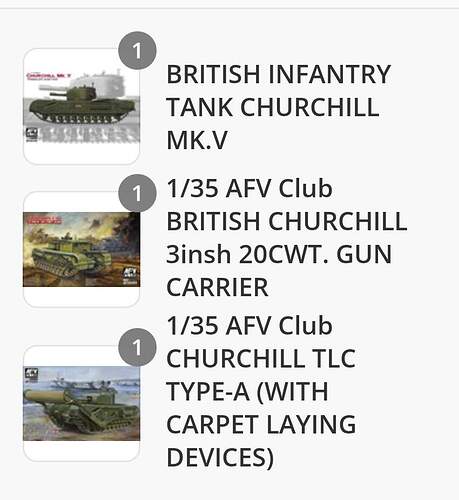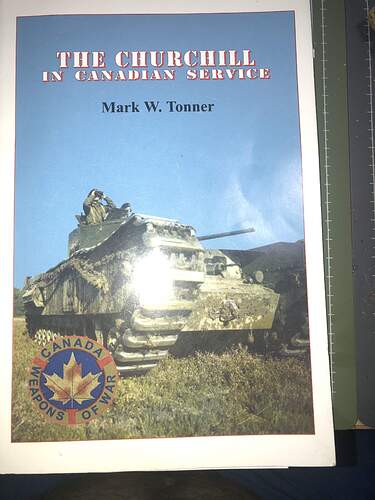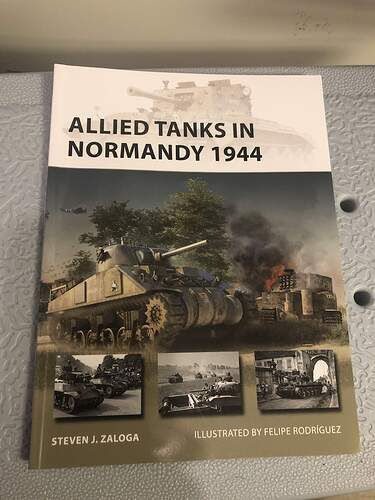Well since I have recently develop a Churchill obsession and have the MK4 AVRE, these decided they wanted to live at my house now .
I picked up the Haynes manual on the Churchill, I am looking for any good websites also that can be recommended.
@Chris_Bryan hi you might want to try this spot:
Service publications: www.servicepub.com
Looking for: The Churchill in Canadian Service
They have a number of publications related to various systems that have been used in Canada. I have noticed a thread mentioning Churchill’s at Dieppe. In this book there’s information on those vehicles since the landing was done by Canadian Regiments both Armoured and Infantry.
My connectivity is problematic otherwise I would have commented on the Dieppe build prior. I get emails to try and keep up with the forums.
Talk to @Mead93. He’s in the middle of scratch building a whole bloody interior for his.
Also, if you visit the YouTube channel for The Tank Museum (Bovington), David Fletcher has a number of videos going over the various marks.
I don’t have any good websites, but I do highly recommend David fletchers book “Mr Churchill’s tank” it talks about everything from the A43 all the way up to the black prince. It talks about everything from doctrine, to the history, subtle variations in each mark etc. It lacks information on the funnies and the Dieppe raid but aside from that, it’s fairly complete. I do believe fletcher has a book on the funnies but youd have to confirm.
The Churchill’s from afv club are fantastic. If they release a black prince I’ll be first in line. I may grab the MkVII at some point
Not surprising that Dieppe isn’t mentioned in a British book on the Churchill since the operation was conducted by the Canadian Army. The British aspect was to land Royal Marines so they could hit the German Kriegsmarine headquarters in an effort to capture a German Naval 4 rotor enigma machine as Fletchly park was unable to crack the naval communications that was needed to route the convoys away from where UBoats were assigned to hunt. Remembering at the time there was a rather large gap in the air coverage between New Foundland, Ice Land and the United Kingdom.
The book I referred to although small in stature does cover its use in the Canadian Overseas Army while the British worked to iron out faults found by the Armour crews using them since they went from drawing board to production without the usual testing carried out prior to entering production because of the urgency to replace the equipment lost at Dunkirk when those armies were boxed between the advancing German Army and the English Channel. Although the Canadian Army did eventually turn the Churchill’s in for 75mm equipped Sherman’s which I did wonder regarding the wisdom of that decision because the 6 pounder had better armour penetration than the 75 mm in the Sherman. In a Osprey book I just received recently regarding the use of Allied armour in Europe actually answered the question regarding why the Canadian Army did not equip itself with the 6 pounder as a tank weapon. Essentially the answer remained in Army Doctrine in the way of the thinking of the British army it used different tanks for different purposes while the American military who entered WW1 in the latter part of that war moved towards combined Arms where the use of the Infantry, Armour and Artillery was combined down into smaller maneuver units in order to not only be able to punch a hole into the lines, they were more easily able to exploit such penetrating maneuvers and hold ground taken by the armour because they had infantry within the combat forces being used in the operation.
Whereas the British experience in the trenches was that infantry was slower and therefore required more heavily armoured tanks that had better HE characteristics in their main weapons while specifically tasked anti tank units handled enemy armour with guns designed for penetration of the armour and because they had a abundance of Sherman tanks to fall back upon felt trading steel was better than using up limited infantry units in attacking and exploiting any penetrating armour in operations which does sort of explain why sometimes it was taking multiple tank attacks into some areas because the following infantry units were not armoured infantry until sometime after D day when they realized the need to be able to do efficiently engage enemy tanks with allied tanks hence the introduction of the 17 pounder fire flys and up gunning the 75 mm Sherman to the 76 mm gun as quickly as possible after the British army decided that combined arms should be embraced within their doctrine. The 6 pounder didn’t have the HE kick wanted so that’s why Canadian Ram tanks and Sherman’s were equipped with the 75 mm gun.
In October 1943 Major Page officer commanding B squadron The Calgary Regiment that not a single tank was pierced by enemy fire, not a single man was wounded inside a tank, even a shot from what was believed to be a 88mm failed to penetrate although it did cause a bulge on the turret wall. Not a single tank was set a fire and as a result of its performance every member of the unit was sold on the Churchill. The problem at Dieppe was the composition of the beach which caused the tanks to shed their tracks. Because of their experiences there Hobarts funnies were created for use during the landings in 1944 and exhaustive beach recce’s were completed by the special ops units of the time including bringing back samples of the sand located on the beaches used on D day.
@Succubus @Mead93 @Canmedic . Guys thank you for all the info. It is nice that other people share this obsession .
@Chris_Bryan I am in the exact same boat. After having no interest in the Churchill tank I now have 5 kits with 1 on the way and 1 on order. I think the uniqueness and variations of the lumbering beast is the appeal. I wish more “funnies” were available in 1/35 styrene kits (including shermans). I will be building the Afv club 95mm CS version first. Could almost start a Churchill campaign.
I just finished reading D-Day To Victory: Diary of a Tank Commander by Trevor Greenwood. A very good insight to the life of a churchill tank crew. Recommended!
@Succubus what is the Allied Tanks in Normandy 1944 book like? I believe it is only new out. Would be good to get your opinion.
TIA,
NICK
@Nickpal01 . They are just beautiful machines . so much variation . Id live to have a Churchill campaign. I need to catch up to you I will only have 4 of them
The fletcher book does cover Dieppe, just not in the detail I would like in terms of reference pictures and stuff still a great book
I ordered as soon as my guys teaser came out. It was definitely worth it as I have books from the place i referred @Chris_Bryan to regarding the Canadian Churchill’s. I have several from that particular publisher because his topics are exclusive to Canadian use of various weapon systems over the last 80 years. Just looking at his listing looks like all the way back to 1935. I have the ones for the 6 pounder, the development of the Ram, the Sherman, the Skink, the Churchill and a number of others. Why I digress is because it was bugging the crap out of me why someone didn’t have the sense to up gun the Sherman to the 6 pounder as it was capable of taking on all the German armour but the heaviest that they fielded. Fantastic penetration compared to the 75 mm that came on the Sherman’s. I was stuck I wasn’t able to find the answer anywhere until I sat in my normal reading area and started perusing the new book on Allied Armour. Not very far in there was a comparison of doctrines in use by the various Allied armies at the time. In there was the answer it was how the British Doctrine used tanks for Infantry support.
Now we need to remember the first Churchill’s had a 3 inch howitzer mounted beside the driver instead of the Besa machine guns that came in the later marks. So the first Churchill’s mounted a 2 pounder in the turret and the 3 inch howitzer in the hull until the rework program replaced the 2 pounder with the 6 pounder in the turret in 1942 with the mark 3 where they also replaced the 3 inch with another Besa machine gun in the Hull. So initially at least the Churchill was dual purpose in being able to take on armour with the turret mount and support infantry against bunkers with the 3 inch gun.
So they go on to explain that the British army had something like 4 times the number of Sherman 75mm tanks than the Americans. So they were quite willing at least initially to basically bleed steel in order to support the infantry. Canadian Doctrine at least for a time mirrored the British Doctrine because of WW1 and the trenches hence the length of the Churchill as they wanted something that could cross trenches with ease and deal with bunkers.
For me finding out that answer was worth buying the book and everything else was a bonus for me. So I guess it depends if you have any nagging questions or not. The book like all Osprey books is well written and very informative without being judgmental or being harsh because of the thinking behind the different doctrines in use at the time.
I am also a fan of the Churchill and have not only the crocodile from tamiya but many of the different ones from AFV so I can represent different marks that were in use throughout the war. Some of the more extravagant ones are far to large for my display space. The one mod I have that I can remember off the top of my head is the NA 75 that was done in Africa and used in the Italian theatre. I also find the carrier Churchill 3 inch gun mk1 rather fascinating as it served with the Canadian army tank brigade heavy support company from September 42 until March 43. Although before getting it I should get built what I have Churchill wise before the wife hangs me. I need more display space but that might happen next year if I’m lucky as it’s still nice in cold  here ice on the bay and my daughter made her first snowman
here ice on the bay and my daughter made her first snowman  on June 7/2021 when we got 5 inches of snow after it had all melted away. She had to wait patiently because in winter is usually - 30 plus windchill and the snow is to dry. She’s five and was so proud of her accomplishment she had even collected the sticks from somewhere for arms we are above the tree line so she’s baffled me on that one.
on June 7/2021 when we got 5 inches of snow after it had all melted away. She had to wait patiently because in winter is usually - 30 plus windchill and the snow is to dry. She’s five and was so proud of her accomplishment she had even collected the sticks from somewhere for arms we are above the tree line so she’s baffled me on that one.
I think the book is worth the read especially if you do allied armour. So I give it a solid 9 and no Russian judge on this one. Hopefully the long answer helps! 🥸😎
Yes that is a huge help , you managed to touch on a couple other vehicles that have my attention . It looks like I need some new books
I was thinking of ordering “The Story of the 79th Armoured Division” for the AVRE and “funnies” side of things. I guess one can never stop learning!
Was just doing the math and to convert a late hull to a black prince , it would be 0.514 mm wider.
This is just the beginning of what would need to be done .
Its a sickness but no model is complete without a bunch of white styrene
I’m tempted to get the GC, and MkVII at some point, shame some of them come with rubber tracks, the styrene workable tracks in the Dieppe MkIII kit look reallly good
The obsession continues between other builds .
So far I have been able to identify 21 different variants of this big beauty .
In addition it appears they were used by 6 countries and was tested in a 7th which was Burma.
Some good info here
Chris, you might be interested in this site:
1:35 Scale Kits (imaco.com.hk)
They do a Black Prince and various other Churchill projects. The Black Prince goes for US$ 159 which doesn’t seem too extravagent in the scheme of things perhaps.
I ordered from them last year (though not a Churchill) and the service was pretty good.


